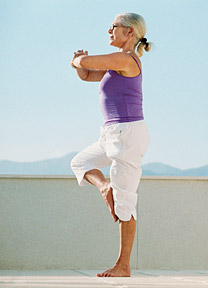3. Yoga
Talk about a powerful exercise routine that can add relaxation and fun to your life! There are many videos available on the subject, but I strongly recommend attending a class for beginners or seniors to ensure proper technique.
Working with an instructor and a group of like-minded, health-conscious people is a wonderful way to get in shape and expand your social circle at the same time.
One of the best health benefits derived from yoga is learning to control your breathing. Breathing from your diaphragm instead of your lungs increases oxygen and blood flow to the cells of your body. The more oxygen you have in your system, the more you increase endurance and longevity. Yoga poses also give your muscles sustained isometric contraction, making them stronger and more resistant to injury.
4. Swimming
Regular swimming builds endurance, muscle strength and cardiovascular fitness. Swimming tones your upper and lower body because you're using almost all of your major muscle groups. There is low risk for swimming injuries because there's no stress on your bones, joints or connective tissues due to buoyancy, and the fact that you weigh one-tenth less in water.
 Start slowly; experts recommend that beginner swimmers start with 12-20 minutes of swimming. Once your strokes become more efficient, your ability to swim longer will, too. For exercise purposes, the best stroke to use in the pool is freestyle - move your arms in a windmill motion while your body pivots and you breathe on the side of the arm that's out of the water.
Start slowly; experts recommend that beginner swimmers start with 12-20 minutes of swimming. Once your strokes become more efficient, your ability to swim longer will, too. For exercise purposes, the best stroke to use in the pool is freestyle - move your arms in a windmill motion while your body pivots and you breathe on the side of the arm that's out of the water.
To keep your swimming routine fresh, mix up the freestyle stroke with other strokes and you'll be working different muscles for a more effective workout every time. Not sure about technique? Take lessons at your local YMCA, YWCA or community center. Detailed descriptions of common swimming strokes (including pictures) are available online through a variety of resources.
5. Bicycling
Of course, cycling is a great way to get around town while saving the environment. It's also a great way to stay healthy. Cycling offers one of the most effective cardiovascular workouts with focus on using your leg muscles, and it's easy on the joints, unlike running. People who ride regularly have improved aerobic fitness, decreased cardiovascular load and increased use of fats as an energy source during physical activity (rather than being stored).
Exercise declines with age, yet cyclists show a smaller decline than those involved in gym activities. Cycling is an activity that you can safely adopt without the risks of more strenuous exercises. A non-sport exercise such as cycling allows year-round participation as part of a daily routine.

